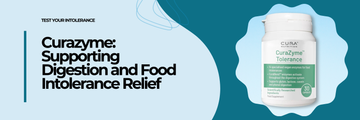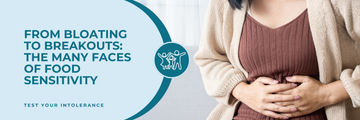By Dr Joseph Nightingale, MBBS, MSc – Advisory Board, Test Your Intolerance
Meet Dr Nightingale: https://www.testyourintolerance.com/pages/advisory-board/dr-joseph-nightingale
Planning on taking a food intolerance test? It’s an accurate, helpful, and non-invasive way to see if you have a food intolerance – and identify the suspected culprits. But the test only works successfully if you’re still eating or drinking the trigger food.
Food intolerance tests measure your body’s response to the trigger foods. If you haven’t consumed these foods in a long time, the residual effects may no longer be present in your body. Just like you can’t diagnose an infection after it’s occurred, you can’t diagnose a food intolerance if you’re not experiencing a reaction.
That’s why what you eat before the test matters more than you think. Here’s what you need to do to get clear answers and avoid any false negatives.
What is a Food Intolerance Test?
Let’s start with the basics.
A food intolerance test—especially one that uses bioresonance or IgG testing—aims to identify whether your body is reacting to specific foods. These aren’t allergies. You’re not going to break out in hives or struggle to breathe. However, you may experience bloating, fatigue, brain fog, or skin issues: the most common food sensitivity symptoms.
Tests either measure your body’s antibody levels (usually IgG4) or assess your bioresonance signature to detect patterns. Either way, the test only works if your body is actively reacting to the food at the time.
That being said, the effects of the foodstuff don’t disappear overnight. Rather, they gradually diminish over time, decreasing the detectable effects. Leave it too long, and you might get a clean bill of health, even if the food is causing your symptoms.
Why You Shouldn’t Avoid Suspected Foods Before Testing
It seems logical to cut out the foods you think are causing problems. But in the run-up to a test? That’s a mistake.
If you’ve been avoiding wheat, dairy, or eggs for the past month, your immune system may no longer be producing antibodies in response. Your body’s “alert system” has gone quiet. That means the test has nothing to measure.
So, when the results come back, your suspected trigger might be marked as “clear.” And you’re left wondering why your symptoms won’t go away.
By continuing to eat the food in question—at least for a few days before your test—you give your body the chance to show what’s really going on.
Can You Get a False Negative on a Food Intolerance Test?
Yes, especially if you’ve been avoiding the food. Without recent exposure, your immune system may stop producing antibodies. That means tests like IgG food intolerance tests or hair sensitivity assessments may miss the culprit altogether.
The Science of Reintroducing Foods
Reintroducing a food works like this:
When you eat something your body reacts to, your immune system may produce low-level inflammation or generate IgG antibodies. These responses can be detected by a blood-based or hair-based intolerance test.
But if you’ve cut the food out entirely, that immune activity slows down or disappears. There’s nothing to detect—no signal, no reaction, no red flags.
That’s why timing is everything. For most tests, your immune system needs to be “primed.” And that means regular exposure to the food in question.
Of course, if you’re not sure which food is the problem, think about when you last experienced symptoms. The nearer you are to that time, the more accurate your results will be.
How to Safely Reintroduce Foods Before Testing
Don’t worry; you’re not being told to binge on dairy or gluten all at once.
The goal is light and controlled exposure. Here’s what to do:
- Start 3–5 days before your test. That gives your immune system enough time to register a response.
- Eat small portions. A slice of bread, a dash of milk in your tea, a spoonful of peanut butter—whatever the food is, you don’t need much.
- Space it out. Once or twice a day is usually enough. You’re not trying to provoke a full-blown reaction. Just reintroduce the item gently.
- Don’t reintroduce everything at once. Stick to one or two potential triggers. If you’re trying to test for dozens of foods, keep a note of what you’ve reintroduced.
- Stop if symptoms are severe. This is about sensitivity, not allergy. If you suspect an allergy or experience swelling, breathing issues, or severe discomfort, don’t reintroduce that food; instead, speak to your GP.
Who Should Reintroduce Foods, and Who Shouldn’t?
Reintroducing foods is generally safe for individuals with mild or suspected food intolerances. But it’s not suitable for everyone.
You should avoid reintroduction if:
- You’ve experienced anaphylaxis or a diagnosed allergy.
- You have coeliac disease and are gluten-free under medical guidance.
- A healthcare provider has told you to strictly avoid a certain food.
When in doubt, speak to your doctor. For most people, though, the reintroduction phase is a critical step in preparing for a more accurate sensitivity test.
Don’t Let False Negatives Hold You Back
Diagnosing your food intolerance isn’t just about the prep work. While it’s crucial to continue eating the trigger food (if safe), you also need to find a comprehensive test. You aren’t going to diagnose your trigger if the test only looks for a handful of foods.
The Complete Intolerance Test by Test Your Intolerance is the gold standard in testing. It analyses a pinprick blood sample for 207 items, including eggs, dairy, meat, wheat, and more. Whether you’re dealing with bloating and fatigue after eating or chronic skin issues, this test provides accurate food sensitivity results in just 5 working days.
Additionally, each kit is CE and UKCA-approved, meeting the highest standards.
Order your Complete Intolerance Test today and take control of your health.









